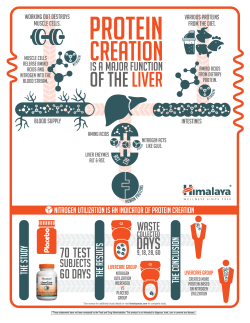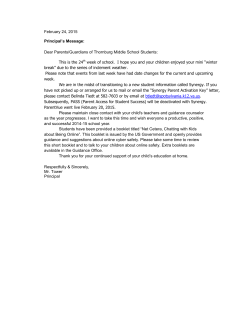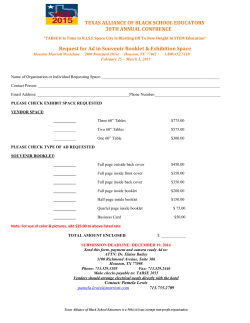
CHEMISTRY Answer ALL questions of the on
Candidate Name: __________________________ CHEMISTRY Option B – Human Biochemistry Tuesday 24 March 2015 51 minutes 34 points _______________________________________________________________________________________ Answer ALL questions of the one option in the spaces provided 1. The structures of the amino acids cysteine and serine are shown in Table 20 of the Data Booklet. They can react with each other to form a dipeptide. (a) (b) (c) 7 State the type of reaction occurring when amino acids react together and identify the other product of the reaction. (2) Draw the structures of the two possible dipeptides formed in the reaction between one molecule of each of cysteine and serine. (2) Six tripeptides can be formed by reacting together one molecule of each of the amino acids arginine, histidine and leucine. Predict the primary structures of these six tripeptides using the symbols shown in Table 20 of the Data Booklet to represent the amino acids. (3) 2. (a) Draw the straight chain structure of glucose. (b) The structure of α-glucose is shown below. (c) (1) Outline the structural difference between α-glucose and β-glucose. (1) Glucose molecules can condense to form starch which can exist in two forms, amylose and amylopectin. Describe the structural differences between the two forms. (2) (d) 1.00 g of sucrose, C12H22O11, was completely combusted in a food calorimeter. The heat evolved was equivalent to increasing the temperature of 631 g of water from 18.36 °C to 24.58 °C. Calculate the calorific value of sucrose (in kJ mol–1) given the specific heat capacity of water in Table 2 of the Data Booklet. (3) 3. Fats and oils can be described as esters of glycerol, C3H8O3. (a) (i) Draw the structure of glycerol. (1) (ii) Glycerol can react with three molecules of stearic acid, C17H35COOH, to form a triglyceride. Deduce the number of carbon atoms in one molecule of this triglyceride. (1) (iii) A triglyceride is also formed in the reaction between glycerol and three molecules of oleic acid, C17H33COOH. State and explain which of the two triglycerides (the one formed from stearic acid or the one formed from oleic acid) has the higher melting point. (3) (b) An oil sample containing 0.0100 mol of oil was found to react with 7.61 g of iodine, I2. Determine the number of C=C double bonds present in each molecule of the oil. (2) (Total 7 marks) 4. (a) (b) The structures of three important vitamins are shown in Table 22 of the Data Booklet. State the name of each one and deduce whether each is water-soluble or fat-soluble, explaining your choices by reference to their structures. (5) Identify the metal ion needed for the maintenance of healthy bones and state the name of the vitamin needed for its uptake. (2) (c) (d) (e) State the name of the vitamin responsible for maintaining healthy eyesight and the name of the functional group which is most common in this vitamin. (2) Identify one major function of vitamin C in the human body and state the name of the most common disease caused by deficiency of this vitamin. (2) Fresh fruits and vegetables are good sources of vitamin C. Explain why some meals made from these foods may contain little vitamin C. (2) (Total 13 marks) Candidate Name: __________________________ CHEMISTRY Option B – Human Biochemistry Tuesday 24 March 2015 51 minutes 34 points _____________________________________________________________________ Answer ALL questions of the one option in the spaces provided 1. Electrophoresis can be used to identify the amino acids present in a given protein. The protein must first be hydrolyzed. (a) State the reagent and conditions needed to hydrolyze the protein, and identify the bond that is broken during hydrolysis. (2) (b) Explain how the amino acids could be identified using electrophoresis. (3) (Total 5 marks) 2. (a) State the empirical formula of all monosaccharides. (b) The structural formula of lactose is shown in Table 22 of the Data Booklet. (c) (1) (i) Deduce the structural formula of one of the monosaccharides that reacts to form lactose and state its name. (2) (ii) State the name of the other monosaccharide. (1) State two major functions of polysaccharides in the body. (2) (Total 6 marks) 3. (a) (b) A brand of vegetable fat consists of 88 % unsaturated fats and 12 % saturated fats. State the major structural difference between unsaturated and saturated fats. Linoleic acid, CH3(CH2)4CH=CHCH2CH =CH(CH2)7COOH, and palmitic acid, CH3(CH2)14COOH, are components of vegetable fat. Explain why palmitic acid has the higher melting point. (c) (1) (3) The energy content of a vegetable oil was determined using a calorimeter. A 5.00 g sample of the oil was completely combusted in a calorimeter containing 1 000 g of water at an initial temperature of 18.0°C. On complete combustion of the oil, the temperature of the water rose to 65.3°C. (d) Calculate the calorific value of the oil in kJ g−1. (4) List two functions of fats in the human body. (2) 4. The structures of two sex hormones, progesterone and testosterone, are shown in Table 22 of the Data Booklet. (a) State the names of two functional groups that are present in both hormones. (b) Identify which of the two hormones is the female sex hormone and where in the human body it is produced. (2) (c) Outline the mode of action of oral contraceptives. (2) (3) (Total 7 marks) –9– N13/4/CHEMI/SP3/ENG/TZ0/XX Option B — Human biochemistry 5. Vitamins are organic micronutrients essential for good health. The structures of vitamins A, C and D are given in Table 21 of the Data Booklet. (a) Identify by name two functional groups that are common to all three of these vitamins. . . . . . . . . . . . . . . . . . . . . . . . . . . . . . . . . . . . . . . . . . . . . . . . . . . . . . . . . . . . . . . . . . . . . . . . . . . . . . . . . . . . . . . . . . . . . . . . . . . . . . . . . . . . . . . . . . . . . . . . . . . . . . . . . . . . . . . . . . . . . . . (b) Only one of these three vitamins is soluble in water. [1] [1] (i) Identify this vitamin. . . . . . . . . . . . . . . . . . . . . . . . . . . . . . . . . . . . . . . . . . . . . . . . . . . . . . . . . . . . . . . . . . . [2] (ii) Explain why this vitamin is soluble in water. . . . . . . . . . . . . . . . . . . . . . . . . . . . . . . . . . . . . . . . . . . . . . . . . . . . . . . . . . . . . . . . . . . . . . . . . . . . . . . . . . . . . . . . . . . . . . . . . . . . . . . . . . . . . . . . . . . . . . . . . . . . . . . . . . . . . . . . . . . . . . . . . . . . . . . . . . . . . . . . . . . . . . . . . . . . . . . . . . . . . . . . . . . . . . . . . . . . . . . . . . . . . . . . . . . . . . . . . . . . . . . . . . . . . . . . . . . . . . . . . . . . . . . . . . . . . . . . . . . . . . . . . (Option B continues on the following page) Turn over 40EP09 – 10 – N13/4/CHEMI/SP3/ENG/TZ0/XX (Option B, question 5 continued) (c) Vitamin D is the only vitamin that can be synthesized in the body, by the action of sunlight on the skin. (i) State one effect of vitamin D deficiency. . . . . . . . . . . . . . . . . . . . . . . . . . . . . . . . . . . . . . . . . . . . . . . . . . . . . . . . . . . . . . . . . . . [1] (ii) Suggest why vitamin D deficiency diseases are becoming increasingly common in young people. . . . . . . . . . . . . . . . . . . . . . . . . . . . . . . . . . . . . . . . . . . . . . . . . . . . . . . . . . . . . . . . . . . . . . . . . . . . . . . . . . . . . . . . . . . . . . . . . . . . . . . . . . . . . . . . . . . . . . . . . . . . . . . . . . . . . 6. Proteins are polymers of 2-amino acids. The structures of the common amino acids are given in Table 19 of the Data Booklet. This question refers to the two amino acids alanine and cysteine. (a) State the structural formula of cysteine as a zwitterion. [1] [1] (Option B continues on the following page) 40EP10 – 11 – N13/4/CHEMI/SP3/ENG/TZ0/XX (Option B, question 6 continued) (b) With reference to the isoelectric points of alanine and cysteine: [1] (i) identify a pH value where both amino acids would be positively charged. . . . . . . . . . . . . . . . . . . . . . . . . . . . . . . . . . . . . . . . . . . . . . . . . . . . . . . . . . . . . . . . . . . (ii) describe with a reason what pH value would be suitable to use in an electrophoresis experiment designed to separate these two amino acids in solution. . . . . . . . . . . . . . . . . . . . . . . . . . . . . . . . . . . . . . . . . . . . . . . . . . . . . . . . . . . . . . . . . . . . . . . . . . . . . . . . . . . . . . . . . . . . . . . . . . . . . . . . . . . . . . . . . . . . . . . . . . . . . . . . . . . . . [2] (c) Cysteine is responsible for a specific type of intra-molecular bonding within a protein molecule. State the name of this type of interaction and outline how it is different from other interactions responsible for the tertiary structure. [2] . . . . . . . . . . . . . . . . . . . . . . . . . . . . . . . . . . . . . . . . . . . . . . . . . . . . . . . . . . . . . . . . . . . . . . . . . . . . . . . . . . . . . . . . . . . . . . . . . . . . . . . . . . . . . . . . . . . . . . . . . . . . . . . . . . . . . . . . . . . . . . . . . . . . . . . . . . . . . . . . . . . . . . . . . . . . . . . . . . . . . . . . . . . . . . . . . . . . . . . . . . . . . . . . . . . . . (d) State three functions of proteins in the body and include a named example for each. Function [3] Named example 1. 2. 3. (Option B continues on the following page) Turn over 40EP11 Option C – Human biochemistry C1. C2. (a) Name: _________________________________ Proteins, carbohydrates and water are important components of a balanced diet. Name three other types of nutrients needed for a balanced diet. [2] (b) The label on a box of breakfast cereal states that a 28.0 g serving has a calorific value of 418 kJ. A 1.00 g sample of this cereal was burned completely and all the heat produced was transferred to 100 g of water. Determine the temperature rise of the water. [3] (a) State the empirical formula of a monosaccharide and list the number and types of functional groups common to all monosaccharides. [3] Draw the straight-chain structural formula of glucose. [1] (b) (c) (d) C3. The enthalpy change of combustion of glucose is given in the Data Booklet (Table 13). Calculate the energy that can be obtained from 1.00 g of glucose. [1] Explain why significantly less energy is obtained per gram from sugars such as glucose than is obtained from oils such as peanut oil. [1] The structure of retinol (vitamin A) is given in Table 22 of the Data Booklet. (a) Identify two functional groups present in retinol. [2] (b) State and explain whether retinol is fat-soluble or water-soluble. [2] (c) (i) (ii) M08/TZ2 Name the light-sensitive substance in the rods of the eye formed from retinol and explain its function. [3] Name two diseases associated with retinol deficiency. [2] Option C – Human biochemistry C1. Name: _________________________________ The two ends of the primary structure of a myoglobin molecule are shown below: X -Val-Leu-Ser-Glu-Gly ----------------------------- Gly-Tyr-Gln-Gly-COOH Val, Leu, Ser etc. refer to the different amino acids in the chain. (a) Identify the functional group represented by X. [1] (b) Name the covalent bond formed between each pair of amino acids in the chain. Draw a diagram of this bond to show clearly the atoms present in it and how they are joined to each other. [2] (c) Describe briefly a technique that might have been used to identify the primary structure of myoglobin. [2] (d) Explain what is meant by the secondary and tertiary structure of myoglobin. [2] (e) Name the type of bond responsible for the secondary structure of myoglobin. [1] C2. (a) (b) Name the type of compound formed when carboxylic acids and glycerol(propane-1,2,3-triol) combine to form fats. Stearic acid and linoleic acid are fatty acids that both have 18 carbon atoms in their molecular structure. (i) (ii) (c) C3. [1] The melting point of stearic acid (Mr = 284) is higher than that of linoleic acid (Mr = 280). Suggest the difference in the structures of the two molecules that accounts for the difference in their melting points. [1] Explain how this difference results in linoleic acid having a lower melting point than stearic acid. [2] Determine the mass of iodine, I2, that reacts with one mole of linoleic acid. [2] Insulin and thyroxine are hormones produced in the human body. (a) State which two parts of the body control their production. (b) For each hormone, state where it is produced and outline one function in the human body. insulin thyroxine [2] [4]
© Copyright 2025









